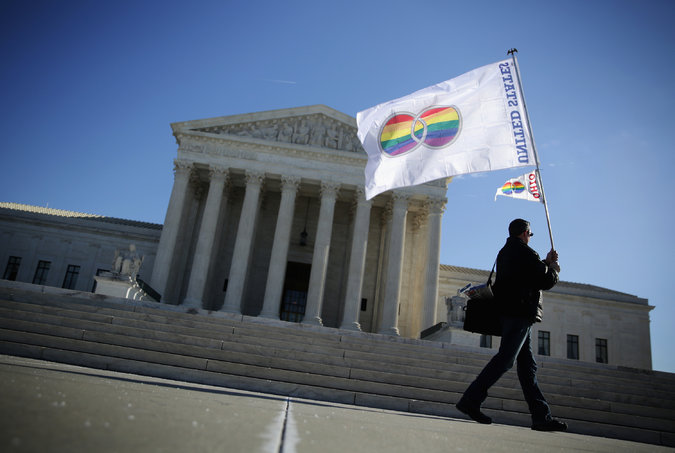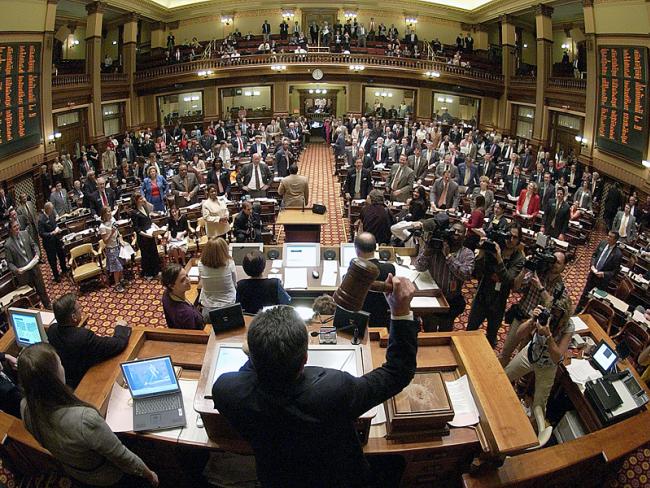By Shaun Kleber

Within the next five months, one of the most controversial social debates of the past several decades may finally have a resolution.
On Friday, Jan. 16, the Supreme Court agreed to hear a case regarding the constitutionality of same-sex marriage. While this is not the first time the Court has considered the issue, changes in both the social and legal environments have experts touting it as a landmark case likely to grant marriage rights to gay and lesbian couples in all 50 states. However, the Court’s relatively noncommittal history with the topic, as well as the controversy surrounding the subject, raises the question: is the Court’s recent announcement primarily a product of pressure from shifting public opinion, or does it have more to do with disagreements among federal courts on the issue?
Advocates have called same-sex marriage the most pressing civil rights issue of the modern era, but it is a far more objective element of the issue that has made this case so pressing. The present legal environment—in which states rely on different laws and court decisions—simply cannot continue indefinitely. “The present status quo is unsustainable,” said state officials in Ohio, who urged the justices to hear the case. “The country deserves a nationwide answer to the question—one way or the other.”
However, that is far from the only reason the Court elected to hear this case. The most obvious reason stems from a decision in November from the United States Court of Appeals for the Sixth Circuit, which upheld same-sex marriage bans in Michigan, Ohio, Kentucky, and Tennessee. This decision is especially important because it runs counter to appellate rulings from the Fourth, Seventh, Ninth, and Tenth Circuits. Previously, all federal appeals courts that had ruled on the issue had struck down same-sex marriage bans in the wake of the 2013 Windsor Supreme Court decision. In fact, a largely unbroken line of more than 40 decisions from state and federal courts relied on the Windsor decision to strike down same-sex marriage bans as each state worked out an individual policy. This most recent decision from the Sixth Circuit, however, established one criterion the Supreme Court looks for in determining whether to hear a case: disagreement among federal appeals courts.
Another element to this case that could explain why the Court elected to hear it—and why so many legal experts are predicting a decision favorable to same-sex marriage—is that public opinion is quickly shifting. In 2003, when Massachusetts became the first state to legalize same-sex marriage, only 37 percent of Americans favored same-sex marriage, with 55 percent opposing it. Now it is the opposite: 58 percent of Americans approve of legalizing same-sex marriage and only 36 percent oppose it. March 18, 2013 was the first day polling numbers showed more Americans supporting same-sex marriage than opposing it. The gap between the two groups has steadily grown since then. The number of states permitting same-sex marriages has increased from one in 2003 to 36 today (plus the District of Columbia), representing more than 70 percent of Americans. Additionally, among people aged 18 to 29, support reaches nearly 80 percent, which sends a strong message about how quickly public support for same-sex marriage will continue to grow in the future.
Clearly the justices of the Supreme Court are not bound to public opinion the same way the elected officials of the other two branches of government are, but research has shown a correlation between the Court’s decisions and public opinion all the same. Two researchers, Lee Epstein and Andrew Martin from Washington University in St. Louis, found that the “mood of the public” does seem to have an effect on Supreme Court rulings. When public opinion is more liberal, the Court is significantly more likely to issue liberal opinions, and the opposite is true when public opinion is more conservative. In other words, court rulings have historically tended to follow public opinion trends.
It is unclear why this is the case, but Epstein and Martin offer two possible explanations. The first explanation is that the Court bends to the will of the people because it needs public support to maintain its efficacy as a branch of government. The second explanation asserts that, because justices are also part of the American public, the same events and forces that affect public opinion also affect them.
Regardless of the reason, historic precedents indicate that while the Court is often responsible for shaping the direction of the country with its landmark decisions, it often follows rather than leads. Same-sex marriage provides another opportunity for the Court to follow. Other than a few exceptions, the message from state and federal courts around the country is clear. The message from the public is becoming clearer with every passing month and year. The Court has the option to continue to avoid answering the ultimate question of whether the Constitution protects the rights of same-sex couples to marry, but this is one of those watershed moments in history when the Court needs to act. Some may malign what they perceive to be undue activism by the justices, but it is precisely that level of activism that has made the United States develop as successfully as it has—because it can adapt. When facing one of the greatest civil rights decisions of this generation, the Court has the opportunity to remind us of its humanity. To remind us that our government still has the ability to interpret a 200-year-old document in the context of our evolving world and expand our conception of equal protection as our society becomes more accepting of all those within it.


